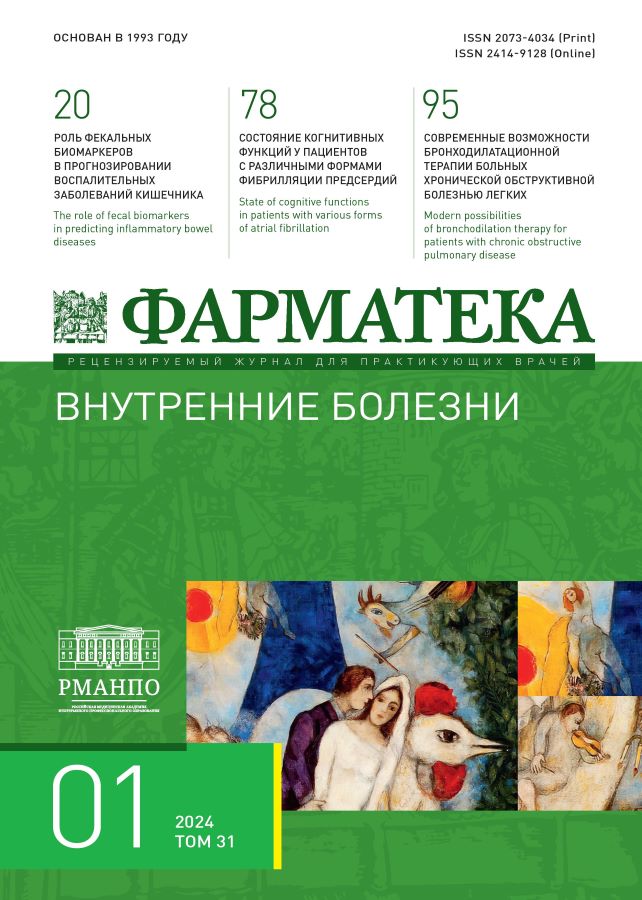VR-IC (virtual reality in intensive care) clinical trial protocol: a program for the prevention of delirium and complications of long-term ICU patients using virtual reality
- Autores: Shiroky R.V.1, Zakaryaeva A.R.1, Murtazalieva D.M.1,2, Zolotov M.A.1, Yakovlev M.Y.2,3, Kvitivadze N.G.1, Parfenov I.P.1, Fomin V.S.1,4
-
Afiliações:
- Veresaev City Clinical Hospital
- I.M. Sechenov First Moscow State Medical University (Sechenov University)
- National Medical Research Center for Rehabilitation and Balneology
- A.I. Yevdokimov Moscow State University of Medicine and Dentistry
- Edição: Volume 31, Nº 1 (2024)
- Páginas: 160-163
- Seção: Neurology
- URL: https://journals.eco-vector.com/2073-4034/article/view/632265
- DOI: https://doi.org/10.18565/pharmateca.2024.1.160-163
- ID: 632265
Citar
Texto integral
Resumo
Background. Delirium is one of the factors that increases the length of stay of a patient in the intensive care unit, and the length of stay of patients on mechanical ventilation leads to an increase in the mortality of patients in the ICU. The incidence of delirium in the ICU reaches 80%. Existing pharmacological and non-pharmacological methods for preventing delirium have not shown sufficient effectiveness, and therefore the search for a method for preventing delirium remains an urgent medical problem. We propose the use of virtual reality (VR) to study the impact of immersive virtual reality on the incidence of delirium in the intensive care unit.
Objective. Evaluation of the effect of using VR on the incidence of delirium and complications of long-term ICU stay.
Methods. The protocol involves conducting a prospective randomized study in the intensive care units (ICUs) of the Veresaev City Clinical Hospital named after of the Moscow Healthcare Department. The study will involve 200 patients in ICUs. Patients will be randomized into equal groups: 100 ICU patients in the control group will receive standard therapy; in the intervention group, in addition to standard therapy, VR will be used 2 times a day. The primary endpoint will be the occurrence of delirium. In addition, patients in our study will undergo EEG monitoring.
Conclusion. VR-IC (virtual reality in intensive care) is the first Russian study of the effectiveness of VR for the prevention of delirium and complications of a long stay in the ICU. In addition, this is the first study to use EEG monitoring to evaluate associations between EEG findings and delirium.
Palavras-chave
Texto integral
Sobre autores
Roman Shiroky
Veresaev City Clinical Hospital
Autor responsável pela correspondência
Email: romanshirokiy@yandex.ru
ORCID ID: 0000-0002-8155-2389
Rússia, Moscow
A. Zakaryaeva
Veresaev City Clinical Hospital
Email: romanshirokiy@yandex.ru
ORCID ID: 0000-0002-5563-4890
Rússia, Moscow
D. Murtazalieva
Veresaev City Clinical Hospital; I.M. Sechenov First Moscow State Medical University (Sechenov University)
Email: romanshirokiy@yandex.ru
ORCID ID: 0000-0002-8162-2359
Rússia, Moscow; Moscow
M. Zolotov
Veresaev City Clinical Hospital
Email: romanshirokiy@yandex.ru
ORCID ID: 0000-0003-0071-8525
Rússia, Moscow
M. Yakovlev
I.M. Sechenov First Moscow State Medical University (Sechenov University); National Medical Research Center for Rehabilitation and Balneology
Email: romanshirokiy@yandex.ru
ORCID ID: 0000-0002-9996-6176
Rússia, Moscow; Moscow
N. Kvitivadze
Veresaev City Clinical Hospital
Email: romanshirokiy@yandex.ru
ORCID ID: 0009-0007-2203-3048
Rússia, Moscow
I. Parfenov
Veresaev City Clinical Hospital
Email: romanshirokiy@yandex.ru
ORCID ID: 0000-0003-2441-872X
Rússia, Moscow
V. Fomin
Veresaev City Clinical Hospital; A.I. Yevdokimov Moscow State University of Medicine and Dentistry
Email: romanshirokiy@yandex.ru
ORCID ID: 0000-0002-1594-4704
Rússia, Moscow; Moscow
Bibliografia
- van den Boogaard M., Schoonhoven L., Evers A.W., et al. Delirium in critically ill patients: impact on long-term health-related quality of life and cognitive functioning. Crit Care Med. 2012;40(1):112–18. doi: 10.1097/CCM.0b013e31822e9fc9.
- Stransky M., Schmidt C., Ganslmeier P., et al. Hypoactive delirium after cardiac surgery as an independent risk factor for prolonged mechanical ventilation. J Cardiothorac Vasc Anesth. 2011;25:968–74.
- Milbrandt E.B., Deppen S., Harrison P.L., et al. Costs associated with delirium in mechanically ventilated patients. Crit Care Med. 2004;32:955–62.
- Moss H., O’Neill D. Aesthetic deprivation in clinical settings. Lancet. 2014;383(9922):1032–33.
- Anderson D.C., Pang S.A., O’Neill D., Edelstein E.A. The convergence of architectural design and health. Lancet. 2018;392(10163):2432–33.
- Zhang Q., Fu Y., Lu Y., et al. Impact of Virtual Reality-Based Therapies on Cognition and Mental Health of Stroke Patients: Systematic Review and Meta-analysis. J Med Internet Res. 2021;23(11):e31007. Doi: 10.2196/ 31007.
- Hoffman H.G., Boe D.A., Rombokas E., et al. Virtual reality hand therapy: A new tool for nonopioid analgesia for acute procedural pain, hand rehabilitation, and VR embodiment therapy for phantom limb pain. J Hand Ther. 2020;33(2):254–62. doi: 10.1016/j.jht.2020.04.001.
- Dubb R., Nydahl P., Hermes C., et al. Barriers and strategies for early mobilization of patients in intensive care units. Ann Am Thorac Soc. 2016;13(05):724–30.
- Rapoliene J., Endzelyte E., Jaseviciene I., Savickas R. Stroke patients motivation influence on the effectiveness of occupational therapy. Rehabil Res Pract. 2018;2018:9367942.
Arquivos suplementares








